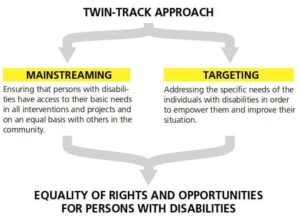In News: The twin-track approach, which is commonly used for advancing rights of marginalised populations, is also applied when promoting disability-inclusive humanitarian action.
About The twin-track approach
- Applying a twin-track approach means ensuring women, men, boys and girls with all types of impairments, being hearing or visual impairment, physical impairments or cognitive impairment, as well as intellectual or learning disabilities have full access to relief operations and protection by removing barriers and facilitating access.
- At the same time, humanitarian actors have to provide specific solutions and individualised support for adults and children, particularly those who may have higher support needs, always with the principle of informed consent, choice and autonomy of the person.
- Here, collaboration with and referral to disabled people‘s organisations and disability-specific organisations is essential.
Examples of support services could be:
- Assistive devices and technology
- Specific rehabilitation interventions and support to families, personal assistants and caregivers
- Targeted pedagogic support to facilitate access to school. Hiring expertise, or referring to speech therapists, psychologists, special educators, etc.). Supportive lessons.
- Early identification and early intervention programs for children with disabilities and support to families,
- Ensuring extra allowance for transportation or additional health care needs for families with a member having a disability.
- Peer to peer support or organising self-help groups to support empowerment and coping strategies
Twin-Track Approach to Disability-Inclusive Policies

Track 1: Targeted, Disability-Specific Policies and Measures
- Targeted, disability-specific measures are those that are created exclusively for the empowerment and inclusion of persons with disabilities.
- RPD Act 2016 (as also the PWD Act 1995 which it replaced) is an example of disability specific targeted legislation. In India, there are also institutional bodies that are exclusively created for the purpose of disability inclusion.
- Disability-specific targeted measures also encompass schemes such as ADIP Scheme of Assistance to Disabled Persons for Purchase/Fitting of Aids and Appliances (ADIP Scheme), Braille Press Scheme and DDRC,Deendayal Disabled Rehabilitation Scheme (DDRS), to name a few.
Track 2: Mainstreaming Disability
Contemporary Policies and Measures towards Mainstreaming Disability Inclusion
- Mainstreaming Disability in Education:
- Sarva Shiksha Abhiyan (SSA) launched in 2001 was more pronounced as far as integrating disabled children were concerned.
- It provided for a cash grant of up to Rs. 1200 per child per year; evolving plans at the district level for students with disabilities and also involvement of resource institutions.
- The Action Plan for Inclusive Education of Children and Youth with Disabilities (IECYD) 2005hasmeasures such as ‘Teachers Preparation in Special Education (TEPSE)’ and Higher Education for Persons with Special Needs (Persons with Disabilities) (HEPSN) 1999-2000 that were primarily launched as a means develop disabled-friendly curriculum and structure targeting teachers in mainstream education.
- Accessible Sanitation Measures:
- The Department of Drinking Water and Sanitation, Ministry of Jal Shakti, Swachh Bharat Mission, created a set of guidelines for accessible Household Sanitation for Persons with Disabilities (December 2015). And the Ministry also broadened the scope of Government assistance for household toilets to include households having persons with disabilities
- Accessible Banking:
- In 2017 RBI released a landmark guideline outlining ‘Banking Facility for Senior Citizens and Differently Abled Persons’, which instructed banks to put in place inclusive mechanisms such as priority service and dedicated counters for elderly and put in place inclusive mechanisms such as priority service and dedicated counters for elderly and persons with disabilities and door step banking for persons with disabilities and elderly persons unable to reach banks.
- Master Circular dated July 1, 2015. In addition, RBI had released a number of other disability-inclusive guidelines such as – RBI Notification dated 19.11.2007 on Operation of Bank Accounts by Guardians appointed under National Trust Act, for Mental disabilities and RBI Notification dated 04.06.2008 Banking Facilities to the Visually Challenged
- Mainstreaming Disability in Poverty Alleviation Frameworks:
- National Rural Livelihood Mission One of the most impactful disability mainstreaming efforts by Indian Government has been within the National Rural Livelihood Mission.
- NRLM Social Inclusion Protocols, dated February 23, 2016 outlines a priority and early inclusion of the poorest of the poor and other vulnerable sections of community including persons with disabilities in rural poor communities.
















